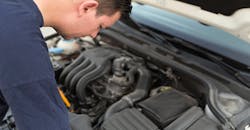The cold weather is not leaving anytime soon, so consider this six-point vehicle check to keep your car in tip-top condition.
“Why not wrap up the holiday season with a gift for you and your car? Inspecting six key systems ahead of time can save you the headaches and cost of an emergency breakdown later,” said Rich White, executive director, Car Care Council. “Regular vehicle maintenance is always more convenient when you're doing it on your own schedule. By taking a few easy preventive maintenance steps now, you can have more confidence when driving in severe winter weather.”
The Car Care Council recommends a six-point vehicle check before the New Year arrives:
- Battery – Keep the battery connections clean, tight and corrosion-free. Cold weather is hard on batteries, so it’s wise to check the battery and charging system for optimum performance. Because batteries don't always give warning signs before they fail, it is advisable to replace batteries that are more than three years old.
- Antifreeze – Antifreeze (coolant) should be flushed and refilled at least every two years in most vehicles. As a reminder, do not add 100 percent antifreeze as full-strength antifreeze actually has a lower freeze point than when mixed with water.
- Brakes – Have the brake system checked. Brakes are critical to vehicle safety and particularly important when driving on icy or snow-covered roads.
- Tires – Check the tire tread depth and tire pressure. If snow and ice are a problem in your area, consider special tires designed to grip slick roads. During winter, tire pressure should be checked weekly as tires lose pressure when temperatures drop.
- Oil – Be diligent about changing the oil at recommended intervals and check the fuel, air and transmission filters at the same time. Consider changing to low-viscosity oil in winter, as it will flow more easily between moving parts when cold. In sub-zero driving temperatures, drop oil weight from 10-W30 to 5-W30 as thickened oil can make it hard to start the car.
- Wiper Blades – Cold weather can affect the life of windshield wipers, making the rubber hard and brittle and increasing the potential for cracks. Wiper blades that are torn, cracked or don’t properly clean your windshield should be replaced. Some manufacturers offer special winter blades that have a rubber boot covering the arm assembly to keep snow and ice out. When changing the blades, have the windshield wiper system nozzles cleaned and adjusted if necessary, and check the fluid level in the windshield washer reservoir.
During the winter, the Car Care Council recommends keeping your vehicl’'s gas tank at least half full as that decreases the chances of moisture forming in the gas lines and possibly freezing. Finally, consider getting a tune-up, because winter magnifies existing problems such as pings, hard starts, sluggish performance or rough idling.
The Car Care Council is the source of information for the “Be Car Care Aware” consumer education campaign promoting the benefits of regular vehicle care, maintenance and repair to consumers. Click here for more information or to receive a copy of the council's Car Care Guide.
About the Author

Sandy Smith
Sandy Smith is the former content director of EHS Today, and is currently the EHSQ content & community lead at Intelex Technologies Inc. She has written about occupational safety and health and environmental issues since 1990.
